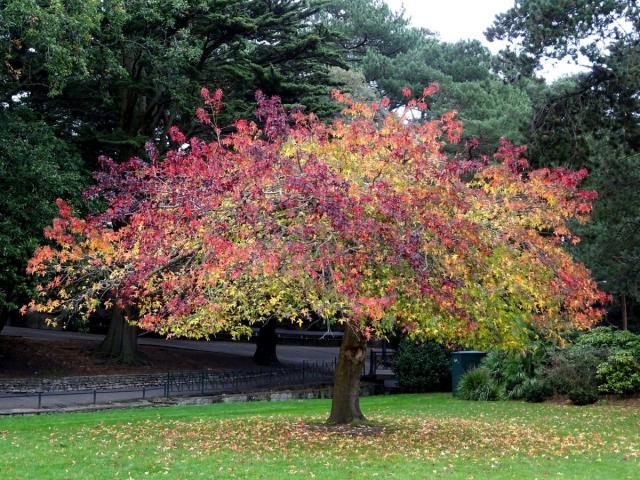When planning a Garden Design, I will always pay special attention to the use of Trees. As they are typically the most expensive item in a Planting Plan and the most difficult to remove and maintain you should apply special consideration to their needs and the effect on the rest of the landscape. Here are some of the things to think about when adding trees in your garden:
Size
Trees are much bigger than shrubs and if you plant the wrong kind of tree, you could find that in a few years time, it is way too big for your garden. Always consider the mature size of a tree, and if you are fixated on a certain type of tree, see if there are dwarf varieties available. Removing a mature tree can take a lot of effort and is often a big expense if you need to hire someone to remove it for you.
While many people manage this by pruning a tree back to control it's size, there is a limit to what you can do before the tree starts to lose it's natural shape, and practices like topping can be very detrimental to a tree's health. Some trees can be kept small by regular pruning, using a technique known as pollarding, but this is only applicable to certain species of tree that can accept this type of pruning. Trees that are suitable for pollarding have the ability to compartmentalise decay, which helps prevent any infections caused by pruning cuts from spreading to the rest of the tree. Trees can be pruned without damaging their health by performing a crown reduction, but this will not reduce the size greatly.
Never trust the tags on a tree for the size information, look it up in a reputable plant guide for your area.
Effect on Shade
When reviewing the mature size of a tree, pay attention to the effect that tree will have on your landscape and the rest of your home. A large tree will cast a generous shadow and this can be have good effects as well as bad. For example, a tree placed on the South end of a South facing garden, may eventually cast shade over the entire space, turning it from a full-sun garden to shade, and some of your sun-loving garden plants may need to replaced with ones that are happier in shade.
In hot summer regions, a large tree that casts shade over your garden will make the space cooler, and if it looms over your home, it can naturally cool your home and help reduce energy bills. Deciduous trees that lose their leaves in Winter, are a great choice for trees like this as they will help cool your home in Summer and allow winter sun to warm your home in the Winter. Allowing milder winter sun to naturally warm your home without overheating it will help reduce your heating bills.
Companion Planting
Some trees are effected by, or can have an effect on the plants near the tree. For this reason, companion plants for trees need to be carefully considered too.
Allelopathy
Some trees are allelopathic, which means that they secrete biochemicals to suppress nearby plant growth. These trees have evolved to produce allelopathic biochemicals to prevent other plants competing for the same resources they need to survive. In a garden environment, allelopathic trees can make it difficult for other plants to thrive.
Here are some common garden trees that are allelopathic:
- Black Walnut (Juglans nigra)
- Eucalpytus (Eucalyptus spp.)
- Elderberry (Sambucus spp.)
- Juniper (Juniperus spp.)
- Sumac (Rhus spp.)
Reduced Summer Watering
Trees that are native to Mediterranean climates are not adapted to having wet soil on their roots. Trees of this type can suffer as they do not have natural defence mechanism to combat microbes that thrive in warm-wet soil, and their roots can start rotting away, which could result in the tree falling over in high winds.
For this reason, it is best not to plant anything under the canopy of trees that need reduced summer watering, unless they are drought tolerant and do not need any supplemental irrigation.
The best practice for risk-averse garden designers is to create a circle under the tree that is bordered from the rest of the garden that has no plants and is covered with mulch. This is also a good idea for any trees that are planned for planting in lawn area - the constant moisture needed to sustain a healthy lawn will often be too much for a tree and even trees that are not Mediterranean natives can suffer root rot in these conditions.
Tree Disease Epidemics
Tree disease epidemics are on the rise, and many common garden trees are highly at risk of dying to due to local epidemics, such as Dutch Elm disease, which killed 90% of the Elm trees in Southern England in the 1970s. In addition to the danger of a tree dying, quarantines are in place in many areas to control the spread of certain diseases. Before selecting any tree for your landscape, check if it is subject to any quarantine requirements, or if there are major disease problems in your area with that species. In an ideal world, nurseries would not be selling trees that are at high risk of disease, or at least advise customers on the disease risk and quarantine issues but they are not always honest or knowledgeable about this, so do your own research before you make a costly mistake.
Hopefully, this gives some food for thought in helping you make decisions on how to apply trees to your garden design. If you have any useful hints or questions about, please let us know in the comments below!

